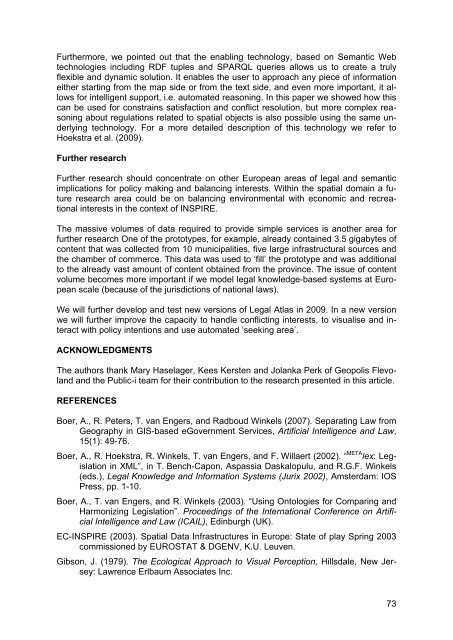SDI Convergence - Global Spatial Data Infrastructure Association
SDI Convergence - Global Spatial Data Infrastructure Association
SDI Convergence - Global Spatial Data Infrastructure Association
Create successful ePaper yourself
Turn your PDF publications into a flip-book with our unique Google optimized e-Paper software.
Furthermore, we pointed out that the enabling technology, based on Semantic Web<br />
technologies including RDF tuples and SPARQL queries allows us to create a truly<br />
flexible and dynamic solution. It enables the user to approach any piece of information<br />
either starting from the map side or from the text side, and even more important, it allows<br />
for intelligent support, i.e. automated reasoning. In this paper we showed how this<br />
can be used for constrains satisfaction and conflict resolution, but more complex reasoning<br />
about regulations related to spatial objects is also possible using the same underlying<br />
technology. For a more detailed description of this technology we refer to<br />
Hoekstra et al. (2009).<br />
Further research<br />
Further research should concentrate on other European areas of legal and semantic<br />
implications for policy making and balancing interests. Within the spatial domain a future<br />
research area could be on balancing environmental with economic and recreational<br />
interests in the context of INSPIRE.<br />
The massive volumes of data required to provide simple services is another area for<br />
further research One of the prototypes, for example, already contained 3.5 gigabytes of<br />
content that was collected from 10 municipalities, five large infrastructural sources and<br />
the chamber of commerce. This data was used to ‘fill’ the prototype and was additional<br />
to the already vast amount of content obtained from the province. The issue of content<br />
volume becomes more important if we model legal knowledge-based systems at European<br />
scale (because of the jurisdictions of national laws).<br />
We will further develop and test new versions of Legal Atlas in 2009. In a new version<br />
we will further improve the capacity to handle conflicting interests, to visualise and interact<br />
with policy intentions and use automated ‘seeking area’.<br />
ACKNOWLEDGMENTS<br />
The authors thank Mary Haselager, Kees Kersten and Jolanka Perk of Geopolis Flevoland<br />
and the Public-i team for their contribution to the research presented in this article.<br />
REFERENCES<br />
Boer, A., R. Peters, T. van Engers, and Radboud Winkels (2007). Separating Law from<br />
Geography in GIS-based eGovernment Services, Artificial Intelligence and Law,<br />
15(1): 49-76.<br />
Boer, A., R. Hoekstra, R. Winkels, T. van Engers, and F. Willaert (2002). “ META lex: Legislation<br />
in XML”, in T. Bench-Capon, Aspassia Daskalopulu, and R.G.F. Winkels<br />
(eds.), Legal Knowledge and Information Systems (Jurix 2002), Amsterdam: IOS<br />
Press, pp. 1-10.<br />
Boer, A., T. van Engers, and R. Winkels (2003). “Using Ontologies for Comparing and<br />
Harmonizing Legislation”. Proceedings of the International Conference on Artificial<br />
Intelligence and Law (ICAIL), Edinburgh (UK).<br />
EC-INSPIRE (2003). <strong>Spatial</strong> <strong>Data</strong> <strong>Infrastructure</strong>s in Europe: State of play Spring 2003<br />
commissioned by EUROSTAT & DGENV, K.U. Leuven.<br />
Gibson, J. (1979). The Ecological Approach to Visual Perception, Hillsdale, New Jersey:<br />
Lawrence Erlbaum Associates Inc.<br />
73

















